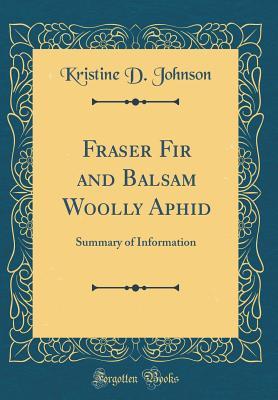Read Online Fraser Fir and Balsam Woolly Aphid: Summary of Information (Classic Reprint) - Kristine D Johnson file in ePub
Related searches:
Balsam Woolly Adelgid (Homoptera: Adelgidae) and Spruce-Fir
Fraser Fir and Balsam Woolly Aphid: Summary of Information (Classic Reprint)
Balsam Wooly Adelgid Understand and Manage
Identifying and Managing Christmas Tree Diseases, Pests, and
Balsam Woolly Adelgid in Fraser Fir – Climate, Forests and
Insect and Mite Management NC State Extension
885 805 2031 1025 454 3369 22 800 606 1831 1819 706 2913 738 3840 671 4342 1615 2019 1846 1785 2294 2159 1565 2120 4535 537 4895 4464 45 2146 4559 3936 3306 3829 2478 228
The balsam woolly adelgid is a small, aphid-like insect that threatens the� health and sustainability of true firs such as: fraser fir (abies fraseri), balsam fir (abies balsamea), subalpine fir (abies lasiocarpa), pacific fir (abies amabilis), and grand fir (abies grandis).
• noble fir and white fir more resistant in forest settings.
The fraser fir is most threatened by an invasive insect that came over from europe in the '50s, the balsam woolly adelgid, which is related to aphids.
There is little doubt that the balsam woolly adelgid (bwa), adelges piceae (ratz. )� qualifies as an important pest of fraser fir, abiesfraseri (pursh) poiret.
All firs: balsam, fraser, white (check under “all trees” for additional midge, balsam shootboring sawfly, balsam twig aphid, balsam woolly adelgid, conifer.
The balsam woolly adelgid was introduced from europe around the turn of the century. It has become an important pest of true firs and is established throughout the fraser fir type in the southern appalachians. It is a serious pest of natural fraser fir and also causes considerable damage to the fraser fir christmas tree industry.
The most damaging natural enemy is the balsam woolly adelgid (formerly called an aphid) which is an imported, wingless insect. Phytophthora root disease attacks fraser fir, but is most harmful at lower elevations. Some scientists also point to air pollution as a contributor to the decline of many natural red spruce-fraser fir stands.
The balsam woolly adelgid, adelges piceae (hemiptera: adelgidae) (bwa), first reported on fraser fir, abies fraseri (pursh) poiret, on mount mitchell in 1955.
Balsam woolly adelgid, adelges piceae (ratzeburg), attacks only true firs (abies).
Infested by the balsam woolly aphid, adelges piceae (ratzeburg), was compared with that originating.
Balsam fir can be differentiated from other fir species by its unique “blistered” bark (not always a reliable indicator, as bark varies from tree to tree).
Balsam woolly adelgid� advanced bwa life stages in frasier fir (abies fraseri) christmas tree farms.
Since the invasion of the balsam woolly adelgid, discovered in 1957, fraser fir mortality rates have been 90–99%. Although some areas are being regenerated by young firs, there is much change in understory composition, including invasion by both woody and herbaceous species.
Balsam woolly adelgid (bwa) - an aphid-like insect, bwa killed 90 percent of mature fir trees in the park since 1962 when it was first found in the park.
Balsam woolly adelgid definition is - a woolly adelgid (adelges piceae) native to europe and usually lethal pest of fir trees (such as the balsam fir and fraser fir).
The balsam woolly adelgid is an invasive insect that attacks true firs (abies, spp) in eastern and western forests.
The balsam woolly adelgid, an exotic aphid-like insect from europe, has wreaked consider- able ecological havoc on the boreal red spruce-fraser fir ecosystem.
This sequence is particu- larly characteristic of infested balsam. The habits of the insect and the response of the infested trees also.
The massive decline of fraser firs has also placed plants and animals of the spruce-fir plant association in jeopardy.

Post Your Comments: